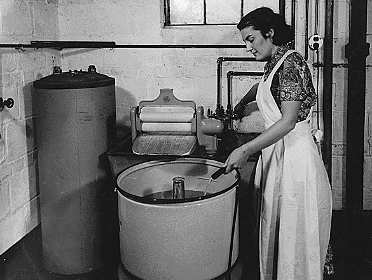New Deal Programs

The New Deal programs refer to a series of programs implemented by the US President Franklin Delano Roosevelt and his Cabinet in the 1930’s with an aim to relieve the Great Depression, the longest and severest economic depression in American history. Although the economic problems came to an end only after the US entry into World War II, Roosevelt’s New Deal has dramatically transformed the American social and economic policy. The New Deal programs are traditionally divided into the First New Deal (1933-1935) which primarily focused on restoration of public confidence in banking and finance sectors, relieving the unprecedented unemployment and stabilizing the agricultural sector, and the Second New Deal (1936-1939) which was marked by a new set of reforms aimed to create new jobs and social security.
Roosevelt’s measures against the Great Depression were characterized by a number of programs and agencies many of which were abolished during the World War II although several are still in force or operating. The most notable New Deal programs include (arranged chronologically):
Civilian Conservation Corps (CCC) established on March 31, 1933, was a public work relief program intended for men between 18 and 25 years of age. It provided work to about 2 million young men in construction and conservation until 1942 when it was abolished.
Federal Emergency Relief Administration (FERA) was a government agency established by the Federal Emergency Relief Act on May 12, 1933, with an aim to provide immediate relief to unemployed masses, usually in the form of direct payments. It did, however, employed a number of people in small-scale public works and local public service. In 1935, it was replaced by the Works Progress Administration (WPA) providing jobs in public work projects rather than direct payments. The Works Progress Administration was renamed as the Work Projects Administration (WPA) in July 1939. It was abolished in 1943.
Agricultural Adjustment Act (AAA) refers to the act that was signed by Roosevelt on May 12, 1933, with an aim to increase crop prices by introducing subsidies for crop reduction. The Supreme Court declared the AAA unconstitutional in 1936. It was replaced by the Agricultural Adjustment Act of 1938 which was virtually the same to the original AAA but it foresaw financing of the program by the federal government instead of processor’s tax.
Tennessee Valley Authority (TVA) founded on May 18, 1933, was both unemployment relief program and regional development agency as construction of the dams on the Tennessee River created new jobs in construction and conservation industries while providing cheap electricity to the region that was hit hard by the Great Depression. This federally owned corporation still exists today and also provides navigation, flood control and land managing for the Tennessee River system.
Homeowners Refinancing Act passed by the Congress on June 13, 1933, provided refinancing of home mortgages and other aid to homeowners in financial difficulties through the newly established Home Owners’ Loan Corporation (HOLC).
National Industrial Recovery Act (NIRA) passed by the Congress on June 16, 1933, tried to stimulate economic recovery by eliminating the cut-throat competition through “codes of fair competition“. The act was implemented by the newly established National Recovery Administration (NRA) but it was criticized for over-regulation by the business owners and was declared unconstitutional in 1935.
Public Works Administration (PWA) that was created by the National Industrial Recovery Act (NIRA) employed millions of people in medium- to large-sized public construction projects such as bridges and dams between 1933 and 1943 when it was abolished.
Civil Works Administration (CWA) was a project under the FEMA which provided temporary work to millions of people during the winter of 1933 and spring of 1934. Rural Electrification Administration (REA) created on May 11, 1935, promoted rural electrification by providing loans to the local governments and cooperatives. It was abolished in 1994, while its functions were transferred to the Rural Utilities Service (RUS).
National Youth Administration (NYA) established in June 1935 provided a part-time employment to students and job training to young people who were unemployed and not in school. The NYA was abolished in 1943.
National Labor Relations Act (NLRA), also known as the Wagner Act (named after its sponsor Senator Robert F. Wagner) was passed by the Congress on July 5, 1935, and prohibited the employers from actions against the workers for taking part in strikes or joining the labor unions. It also established the National Labor Relations Board (NLRB) to investigate unfair labor practices.
Social Security Act (SSA) signed by Roosevelt on August 14, 1935, relieved poverty among senior citizens by providing pensions to the elderly above the age of 65 who contributed to the pension system and financial aid to people unable to work.
Federal Project Number One refers to a series of projects under the WPA including the Federal Writers’ Project (FWP), Federal Theatre Project (FTP) and Federal Art Project (FAP). It was created in August 1935 and employed writers, artists, actors and others throughout the country and made art and culture available to the general populace. The Project was abolished with the dissolution of the WPA in 1943.
Housing Act of 1937, also known as the Wagner-Steagall Act established a public housing program according to which subsidies were to be paid by the federal government the local public agencies providing housing to families with low income.
Fair Labor Standards Act of 1938 (FLSA) established a national minimum wage, overtime pay and forty-hour week for most workers, and prohibited child labor.
Farm Security Administration (FSA) replaced the Resettlement Administration (RA) in September 1937. Like its predecessor, the FSA was created to fight the rural poverty by providing loans and moving poor farmers to the government-owned land. It also sponsored a photography program which documented the rural poverty during the Great Depression.




